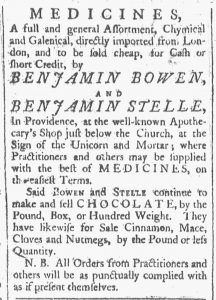What was advertised in a colonial American newspaper 250 years ago today?

“At the Sign of the Unicorn and Mortar.”
On the first day of September in 1770, Benjamin Bowen and Benjamin Stelle advertised “MEDICINES, A full and general Assortment, Chymical and Galenical,” in the Providence Gazette. They informed prospective customers that they could purchase these medicines “at the well-known Apothecary’s Shop just below the Church, at the Sign of the Unicorn and Mortar.” In case that shop was not as familiar to readers as Bowen and Stelle suggested it might be, they named the sign that adorned it. That landmark identified the exact location to acquire “the best of MEDICINES” and “CHOCOLATE, by the Pound, Box, or Hundred Weight.”
Newspaper advertisements placed by entrepreneurs like Bowen and Stelle testify to the visual landscape that colonists encountered as they traversed the streets of towns and cities in eighteenth-century America. In addition to the “Sign of the Unicorn and Mortar,” that same issue of the Providence Gazette included directions to John Carter’s printing office at “the Sign of Shakespeare’s Head.” Not all advertisers always included their shop signs in their notices. Joseph Russell and William Russell placed an advertisement for gun powder and shot that did not make reference to the “Sign of the Golden Eagle.” On other occasions, however, they were just as likely to include the sign without their name, so familiar had it become in Providence.
Very few eighteenth-century shop signs survived into the twenty-first century. Evidence that the “Unicorn and Mortar,” “Shakespeare’s Head,” and the “Golden Eagle” once marked places of commercial activity and aided colonists in navigating the streets of Providence and other places comes from newspaper advertisements and other documents from the period. Any catalog of such signs draws heavily from advertisements since colonists so often referenced them in their notices. Even those who did not have shop signs of their own listed their locations in relation to nearby signs, suggesting the extent that shop signs helped colonists make sense of their surroundings and navigate the streets of towns and cities.
